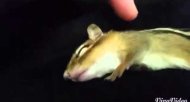7 Cool Facts about Chameleons | Pet Reptiles
You already love Spotify, but do you know how to get the most out of it? Click here to learn all the Spotify Tips and Tricks you never knew existed. http://bit.ly/1VfW63R
Great Amazon Must Haves for any Reptile Owner:
Zoo Med Reptile Shelter 3 in 1 Cave: http://amzn.to/1JyH7IK
Exo Terra Monsoon Rainfall System: http://amzn.to/1fVndz5
Zoo Med Desert Repti Sand: http://amzn.to/1iihdCj
HERPTIVITE Multivitamin for reptiles and amphibians: http://amzn.to/1UnuieR
Watch more How to Take Care of Reptiles & Amphibians videos: http://www.howcast.com/videos/512393-...
Let other people have cats and dogs! Jungle Bob is here to show you that owning a pet reptile or amphibian is not as crazy as you might think. In this video, he tells you seven cool facts about chameleons.
Chameleons are lizards that are native to Africa and Madagascar in particular, but we also find them in the Saudi Arabian peninsulas, in northeastern part of Africa. The animal we see there is the veiled chameleon.
All Chameleons are some of the most unusual of all the lizards, starting with their splayed foot. They are tree lizards. They like to stay hidden in the canopy if they're in a rain forest environment, or these types of animals we've found in desert oases where they're feeding on insects, or other lizards, anything they can get their tongue on. They have a splayed foot and a splayed hand, meaning there are two toes on one side and three on the other, allows them to perfectly grasp branches.
Most of them, veiled chameleons, certainly ,has a prehensile tail. It can use that as a fifth limb and hang on in the trees when troubles there.
Its eyes are one of the most interesting of all animal creatures in that its eyes rotate independently of each other. They can see up and down, or left and right at the same time, and that really aids them in their main task, which is eluding other predators. These animals are completely skittish. They are frightened to be out in the open. That's why this one is being so active.
The mistake about them is that they do change colors, but the mistake about them is that change to every color in the rainbow, you see that more in cartoons when a chameleon walks by a striped object and turns striped. He walks past polka dot and turns polka dot. That does not happen, but the animal can change every bit of its skin to different colors when it wants to.
Here he's grabbing on with his tail and hind legs, and since we've started shooting, you'll see he's grown a white strip down his middle. He's put these patches out here of white, and he's darkened his whole body. He will darken and lighten and change colors based on his mood, which right now is not happy, because he's secretive and wants to be hidden. He's always trying to hide behind the branch, and making his body very lateral to merge with the branch, in order to escape us seeing him. He's not going to be happy until he camouflages himself, and there he goes hiding.
Up at the top we see baby ones who aren't worried about that, but every chameleon is more worried about camouflage than anything else i. So, they can change colors, that's for sure.
There's a variety of different types of chameleons. They can change colors based on their mood, based on seeing a rival, based on seeing a mate. Their prehensile tail and their moving eyes and then their herky, jerky type of motion, they walk like Michael Jackson used to do the moon walk. They go back and forth, because they want to stay hidden from anybody that's looking to eat him.
In nature, their last bit in their arsenal to stay hidden is they move backwards and forwards. Their eyes are always looking for predators and for prey. Once they find a prey item, their eyes turn forward almost like a gun about to go off. They focus on what they're trying to eat and then their tongue comes out, almost the length of their entire body. It's got a sticky wad on the end, and it'll grab the prey, pull it back into its mouth, and make a meal out of it. That way, they don't have to lurch forward and be exposed to potential predators while they're eating.
Everything about the chameleon is an effort to hide, and the veiled chameleon is one of the best.



















Add comment